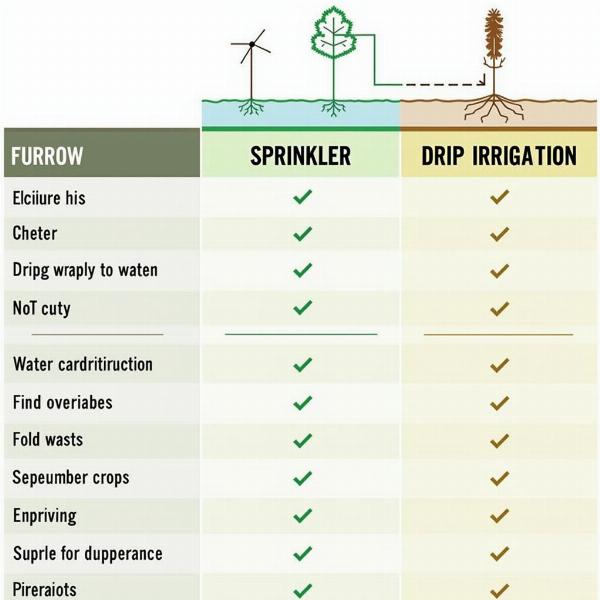Furrow irrigation meaning in Hindi is “नाली सिंचाई” (nali sinchai). This traditional irrigation method involves creating small channels or furrows between crop rows and allowing water to flow down these furrows, saturating the soil and providing water to the plant roots. Understanding furrow irrigation is crucial for efficient water management and maximizing crop yields, especially in water-scarce regions of India.
Understanding Furrow Irrigation (नाली सिंचाई)
Furrow irrigation, known as nali sinchai in Hindi, is one of the oldest and simplest irrigation methods. It is particularly suitable for row crops like sugarcane, maize, cotton, and vegetables. The process involves digging shallow trenches or furrows between crop rows and directing water from a source, such as a canal or well, to flow through these furrows by gravity. The water then seeps into the soil, providing the necessary moisture for plant growth.
Advantages of Furrow Irrigation
- Cost-effective: Furrow irrigation requires minimal equipment compared to other methods like sprinkler or drip irrigation, making it a relatively inexpensive option for farmers.
- Suitable for various soil types: This method can be adapted to different soil textures, from sandy to clayey soils, although adjustments in furrow dimensions and flow rates may be necessary.
- Easy to implement and manage: Furrow irrigation does not require specialized technical knowledge or skills, making it accessible to farmers with limited resources.
Disadvantages of Furrow Irrigation
- Water wastage: Compared to more modern methods, furrow irrigation can lead to significant water loss due to evaporation and runoff, particularly in hot and dry climates.
- Uneven water distribution: Achieving uniform water distribution across the field can be challenging, especially on uneven terrain, leading to some areas receiving excess water while others remain dry.
- Soil erosion potential: The flow of water through furrows can cause soil erosion, especially on slopes or in areas with heavy rainfall.
- Labor intensive: While the system itself is simple, managing and maintaining the furrows can be labor-intensive, especially in larger fields.
How Furrow Irrigation Works
The key to successful furrow irrigation lies in proper furrow design and water management. The dimensions of the furrows – width, depth, and spacing – depend on factors like soil type, crop type, and slope of the land. The flow rate of water must also be carefully controlled to ensure adequate infiltration and minimize runoff. Effective water management in furrow irrigation is essential to optimize water use and prevent wastage.
Designing Furrow Systems
Designing an efficient furrow irrigation system involves considering various factors such as:
- Soil type: Sandy soils require shorter furrows and higher flow rates, while clayey soils need longer furrows and slower flow rates.
- Crop type: Different crops have different water requirements, and furrow spacing should be adjusted accordingly.
- Land slope: On sloping land, contour furrows are used to reduce runoff and erosion.
Modernizing Furrow Irrigation
While traditional furrow irrigation has its limitations, modern techniques can improve its efficiency and reduce water wastage. These include:
- Surge irrigation: This involves applying water in cycles or surges, allowing the soil to absorb water more effectively and reducing runoff.
- Laser leveling: Using laser technology to level the field ensures uniform water distribution across the furrows.
- Automated gates and controls: Automating the opening and closing of gates can improve water management and reduce labor costs.
Furrow Irrigation vs. Other Methods
Compared to other irrigation methods like sprinkler and drip irrigation, furrow irrigation offers a lower initial investment cost but may have higher operating costs due to water wastage. Sprinkler and drip irrigation are more efficient in terms of water use but require more sophisticated equipment and technical expertise. Choosing the right irrigation method depends on factors like crop type, water availability, and budget.
 Comparing Irrigation Methods
Comparing Irrigation Methods
Conclusion
Furrow irrigation (nali sinchai) remains a relevant irrigation method in India, especially for small-scale farmers. While it faces challenges in terms of water efficiency, modern techniques and careful management can improve its performance and contribute to sustainable agriculture. Understanding the principles of furrow irrigation is essential for optimizing water use and maximizing crop yields.
FAQ
- What is the meaning of furrow irrigation in Hindi? Furrow irrigation is known as “नाली सिंचाई” (nali sinchai) in Hindi.
- What are the main advantages of furrow irrigation? It’s cost-effective, suitable for various soil types, and easy to implement.
- What are the disadvantages of furrow irrigation? It can lead to water wastage, uneven distribution, and soil erosion.
- How can furrow irrigation be made more efficient? Modern techniques like surge irrigation and laser leveling can improve efficiency.
- Is furrow irrigation suitable for all crops? It is most suitable for row crops like sugarcane, maize, cotton, and certain vegetables.
- What is the difference between furrow and sprinkler irrigation? Furrow irrigation delivers water directly to the soil surface, while sprinkler irrigation sprays water over the crops.
- What is the most water-efficient irrigation method? Drip irrigation is generally considered the most water-efficient method.
sprinkler irrigation meaning in hindi
Meaning-Hindi.in specializes in providing high-quality Hindi translation services for businesses and individuals. We offer a range of translation solutions, including document translation, website localization, and interpretation services. Our expert linguists ensure accurate and culturally appropriate translations. Contact us today for your Hindi translation needs! Email: [email protected], Phone: +91 11-4502-7584. For more information, visit Meaning-Hindi.in.